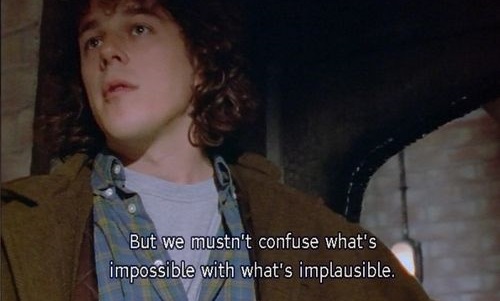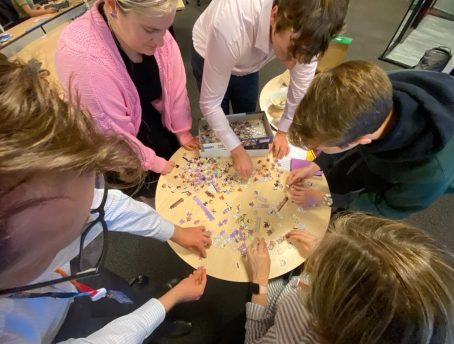The Building Detective (LI Teaser)

Maddy:
Jonathan, we’re looking at a scenario for which there is absolutely no conceivable explanation.
Jonathan:
There’s always an explanation. You’ve just got to think round corners. Don’t always see what you’re meant to see.
Jonathan Creek, written by David Renwick, BBC (1998)[1]
You don’t have to be a building surveyor to call yourself someone who collects data and solves problems. All of us do both every day. You do it when your train is delayed, or when you run out of milk at 6am. You’ve done it to complete a jigsaw puzzle.
Say you’ve got yourself a 1,000 piece puzzle, what are some of the first things you do? You begin to problem solve. First you break down the task. You begin with searching for the edge pieces, each straight edge jumping out from the pile. If you’re lucky, you come across all four corners during this first step. The pieces with edges, together with the corners, are all data points. It’s information you already know how to identify, structure, and how they relate to each other. Once you’ve found the edges of your problem, you’ve defined the scope of your problem.

Once a lot of edges have been collected, it starts getting harder and there’s not as many edges jumping out of the pile any more. However, whilst you were collecting edges you identified a new data point; you recognised colour groups from the image on the box. You already started the next step in solving the problem: allocating similar coloured pieces into their own piles.
You’ve broken the problem of solving the jigsaw puzzle into distinct tasks which you can now close out one by one until the puzzle is solved. As you progress, a picture becomes clearer and clearer. The puzzle is not yet complete, but you’re now able to confirm with a high degree of confidence that it is indeed the picture that is on the box and can describe it adequately to someone else. This jigsaw metaphor is a simple way to describe how detectives work, indeed how building consultants work, or how anyone solves a mystery.
The strange thing about being a professional building pathologist, is that I’ve never constructed anything with my bare hands. All of my knowledge, especially in the beginning, was read. Such is university; a particular challenge for someone who learns by doing and learns even more by making mistakes. To find yourself assessing the condition of the built form, having only ever seen it’s concealed elements, it’s substrate, in diagrams within textbooks, is enough to make you feel like an imposter. A lot of imagination and visualisation is put to work and continually exercised when learning construction technology; the subject of understanding construction materials, techniques and processes. Today, YouTube is a valuable resource where you can find a video of nearly anything being built, so that you can see the process, the order, and what specific building types and elements should look like and interface with each other underneath their exposed finishes. All of this goes a long way to support a building consultant’s ability to visualise what should and shouldn’t be present.
Sight isn’t the only sense at our disposal. Our sense of smell can pick up the musty notes of dampness or fungus, springing a new line of enquiry. Our sense of hearing is engaged when tapping plasterboard or ceramic tiles may reveal a hollow sound indicating a void where there shouldn’t be one. The touch of an internal wall confirming where heat is radiating from, may indicate that the insulation has deteriorated or dropped, no longer shielding the room from the sun blasted brick veneer wall on the other side. Observations are the sum of using all of your senses to perceive the world around you.
Building detectives don’t stop at their senses alone. An arsenal of devices and equipment are at their disposal that either collect data or augment their senses. Even animals can augment our senses, like dogs trained to sniff out timber rot (insert classic rottweiler joke), or sniff out hydrocarbons in suspected arson cases. As clues and questions continue to reveal new lines of enquiry, equipment helps progress each enquiry as much as possible, hopefully to the point where the line of enquiry can be eliminated. Elimination should provide a sense of satisfaction as it is genuine progress. Once we’ve tested all of our hypotheses, deductions, theories and correlations, then done all we can to disprove what remains, we may have arrived at our best guess as to the cause, or collection of causes of an issue. A possible conclusion.
Solving a problem can be approached in one of two ways: using a deductive process or a comparative process. The deductive process requires you consider your observations to come up with ideas for the cause of the problem and then assess whether they fit the evidence. The comparative process is where the evidence is matched with the characteristics of a cause. There is always a danger in making a decision as to the cause of a problem too quickly, particularly if for each problem there may be many causes that could fit the observations or data. Conclusions must arise from critical thought and not just the first thing that comes to mind. The feeling of triumph that comes with being right can be a very strong one that strokes our ego. When we have this feeling, it’s wise to practice recognising it and being real with yourself. Ask yourself what’s more important; being right or the truth? The answer is clear to a professional acting with integrity. They will admit when they don’t have enough information and openly declare their limitations.
Broadly speaking, the whole process is like any scientific experiment: observation, deduction, elimination and finally a conclusion. I offer ODEC.
Observation
This really means in the broadest possible terms, all of the relevant data you can get your hot hands on. It includes all your observations, be it visual, or collected using equipment. It includes documentation and interviews. An observation that’s often neglected at first, but can be critical, relates to the dimension of time. It’s easy to see how this can be neglected, we are all pressed for time, held to deadlines for deliverables. We often don’t have the luxury of observing if something changes or presents new information when viewed across four seasons. However, the detective will do themselves a disservice if they do not consider perspective. Perspective represents multiple opportunities to collect relevant new observations, be it to get down on the ground and look upwards, or to review something in the context of years instead of hours. Make sure you spend time looking for longer-term, slower-paced information. If you’re standing 2 meters in front of a wall, make sure to walk back and look at the wall in its widest possible context. Multiple perspectives are the key.
There are pitfalls in collecting observations. In his great book about interpreting data and statistics, Tim Harford shows us that we shouldn’t immediately trust data simply based on the reputation of its source, or the way it’s presented.
29
the number of words in the preceding sentence.[2]
Never dismiss the possibility for an agenda to manipulate data, or for research to produce data that is simply erroneous. The correct number is 32. The observation stage of our investigation permits us to collect such data, as we’ll take responsibility for testing it and thereby possibly eliminating it. As the Russian proverb goes, trust, but verify.[3]
At this stage we’ll collect everything we can that might be relevant to our investigation. Including asking questions and simply listening and recording. Good questions are those crafted in such a way that they can draw out new evidence. As demonstrated by our dummy statistic, facts can be misleading, where rumours, true or false, can be revealing.[4] We revealed a truth that something can be wrong, or the possibility that something is being hidden. Like Edison noted of his experiments, “I’ve not failed, I’ve found 10,000 ways that don’t work.”
Deductions, Correlations, Theories & Hypotheses (DCTH)
We want to reach a conclusion, and producing deductions is the way to get there. We deduce when we propose a conclusion by drawing a logical connection between observations. It’s time to use all of our observations and get down to business. Deductions can be downright fanciful. Nonetheless, we’ll get around to testing them in order to get closer to a conclusion.
I’ve included other language that are features of the scientific method, and sort of bagged them all together for ODEC, lumping them under D for ‘deduction’ to create a memorable enough mnemonic device that is also phonic: OH-DECK. The other linked activities I’ve grouped with deduction include coming up with correlations, theories and hypothesis.
A correlation is a mutual relationship or connection between two or more things. What’s the difference between correlation and causation? While causation and correlation can exist simultaneously, correlation does not imply causation. Causation means one thing causes another, in other words, action A causes outcome B. Correlations are symmetrical. Proving that they are correlated is proving nothing more than their data is linearly symmetrical. Making a correlation means you still have to prove causation.
A theory is a thought-out explanation for something using observations and hypotheses. Which brings us neatly to the last Inception level of DCTH, the hypothesis; a testable statement about the relationship between two or more variables, or a proposed explanation for an observation.
Sometimes it’s hard to see things because you think a certain way. A detective doesn’t have to be a lone wolf. This is not a cause for concern, it’s a demand for diverse thinking. That is the ultimate strength of a diverse team, they can solve the most complex of mysteries. Consider the tomato sauce example. Take two types of people, one keeps the tomato sauce in the cupboard, and the other person keeps their tomato sauce in the fridge. When the person that keeps the sauce in the cupboard runs out of sauce, they look for alternatives in the cupboard, perhaps finding things like mustards or BBQ sauce. Where does the other person look when they run out of tomato sauce? They look in the fridge and their alternatives are altogether different; mayonnaise and so forth. Sometimes you have to acknowledge that your brain thinks a certain way, to be able to release yourself to be open to an altogether different way of thinking. Consider the following sentence for example: Thiss sentence has threee errors.[5]
In her book A Mind for Numbers Barbara Oakley explains how our brain works when it is working on solving a problem. She proposes it has two modes: focus and diffuse mode. Focus mode is self explanatory. Diffuse mode is where your brain can perform problem solving feats. To enter diffuse mode, you must leave the problem alone, not think about it, and go and do something else. Speaking personally, I can attest to this having experienced this phenomenon time and time again. I experience diffuse mode when I exercise.
When we take a break from working on a problem our brain continues to tinker away with it in the background, especially when you’ve managed to turn your attention to something else. Even when you’re asleep. I often have these ah-ha moments when I go for a run or when I’m driving. The idea gives credence to the saying, anyone who’s had a shower has had an idea (though a different, rarer type of person will follow up with the execution).
Elimination
You now inch closer to the finish line by regarding your list of DCTH and starting with just one, figure out how to rule it out. Prove it wrong. Test it. Elimination may draw out further questions, and produce more deductions. This loop will get smaller as you begin to rule each DCTH out. When you are left with just one, it might be the conclusion. When you are left with more than one, consider that they might all be true, whether they are connected or not.
Conclusion
For a building pathologist, reaching a conclusion, or a probable conclusion, is the same as reaching a diagnosis; determining the nature and cause of an issue. A conclusion is often coveted as a kind of perfect, infallible, explanation for your problem or issue. Often however, this is unrealistic and for complex issues, not possible. Just as an incomplete jigsaw puzzle can be complete enough to reveal its picture, a degree of probability for a likely conclusion might be as close as you get, and it’s a mark of a careful professional to ensure this point is made clear. A good level of probability should still be enough comfort to be able to reasonably act upon and make decisions.
Having introduced ODEC, we can move onto everyone’s favourite part of solving a mystery: the part where the enigmatic detective stands before the interested parties to deliver the dramatic reveal. They don’t simply show their cards, no. They tell a story.
In part 2, I will tell the story of Behailu Kebede, who lived in flat 16 on the fourth floor of a 24 storey residential tower. I’ll show ODEC in the context of arguably the most important public inquiry to affect the entire modern era property and construction industry.
CJLM
[1] Renwick, David. Jonathan Creek, BBC (1998)
[2] Harford, Tim. The Data Detective: Ten Easy Rules to Make Sense of Statistics. Riverhead Books, 2 February 2021
[3] Reagan, Ronald (1987)
[4] Tarantino, Q. (Director, Writer). Inglourious Basterds. Universal Pictures, The Weinstein Company, A Band Apart (2009)
[5] Oakley, Barbara. A Mind for Numbers: How to Excel at Math and Science (Even If You Flunked Algebra). Tarcher, 24 September 2014
